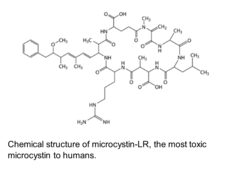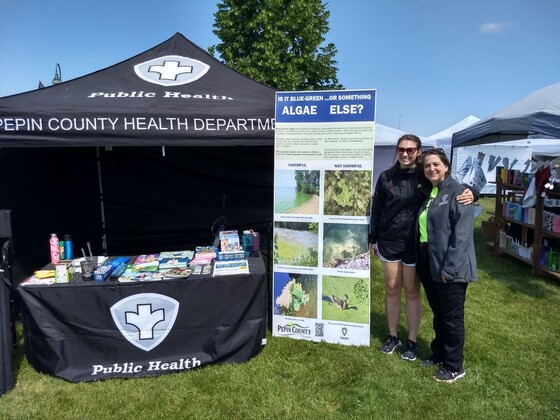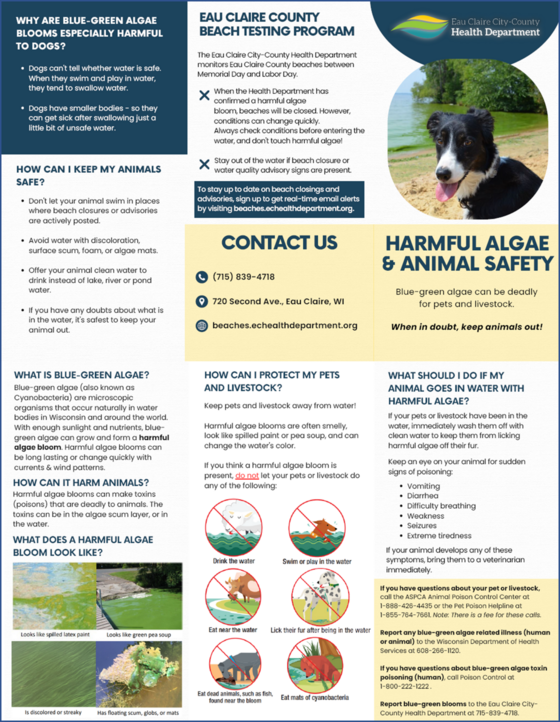 It's Summertime!
Sun and sand aren’t the only things Wisconsinites may find during their trip to the beach…
With cyanobacterial harmful algal bloom (cyanoHAB) season in full swing, it’s as important as ever to educate the public about the effects that cyanobacteria (blue-green algae) can have on humans, animals, and the world around us. This newsletter explains the different types of cyanotoxins that cyanobacteria can produce, their health effects, and how HABs can impact the economy—you’ll also have the opportunity to learn about some neat summer outreach efforts lead by a couple of our local health department partners.
Cyanobacteria and Cyanotoxins: The Mean, Blue-Green, Fighting Machines
What are cyanotoxins and how do they affect health?
Cyanotoxins are natural poisons that are produced by some species of cyanobacteria. There are four main types of cyanotoxins that are found in Wisconsin waterbodies.

Microcystins are a group of hepatotoxins that can cause damage to the liver, kidneys, and reproductive system. Mild exposure can lead to less severe gastrointestinal symptoms, such as nausea, vomiting, diarrhea, and abdominal cramping. Severe cases of exposure can result in liver damage or failure. They are the most common cyanotoxins and are produced by cyanobacteria such as Microcystis, Dolichospermum, and Planktothrix—all of which happen to be among the most plentiful cyanobacterial species present in Wisconsin waters.
Cylindrospermopsin is another hepatotoxin we see in Wisconsin. It has the ability to cause damage in other body systems on a cellular level (also known as cytotoxicity). Like microcystin, severe cases can result in liver and kidney damage. Ingesting or inhaling this toxin at a lower dose can cause nausea, vomiting, diarrhea, sore throat, cough, and congestion. Unlike other cyanotoxins, dermal contact with cylindrospermopsin is not known to cause skin irritation. This cyanotoxin is produced by Cylindrospermopsis, Aphanizomenon, Lyngbya, and Dolichospermum.
Anatoxin-a is a neurotoxin that can cause effects such as numbness, tingling, muscle twitching, and even paralysis and death when exposed in large doses. This toxin has primarily affected animals in the past, but is also associated with a handful of non-lethal human poisonings. It is produced by Dolichospermum, Aphanizomenon, and Planktothrix.
Saxitoxins are a group of potent neurotoxins that are best known as the cause of paralytic shellfish poisoning. As that name suggests, most saxitoxin-related illness in people is caused by eating contaminated fish or shellfish, and it can cause the same damage to the nervous system as anatoxins. While the majority of saxitoxin poisoning occurs in marine waters, some species of cyanobacteria in freshwater bodies—including Dolichospermum, Aphanizomenon, Planktothrix, Cylindrospermopsis, and Lyngbya—are also capable of producing saxitoxins.
|
Do cyanotoxins cause cancer?
The short answer is that we are unsure—for now. There has not been enough research about the relationship between cyanotoxins and cancer to make an indisputable connection. For this reason, the EPA has officially determined that there is “inadequate information to assess carcinogenic potential” of cyanotoxins at this time. This position may change as more clinical and epidemiological studies are published in the future.
Here is what we do know:
- Data from laboratory studies suggest that microcystins act as tumor promoters but not tumor initiators. This means that they may not directly cause cancer, but they do cause the rapid cell growth required for cancer to spread, particularly in the reproductive system.
- Microcystins in untreated or inadequately treated drinking water sources were found to be connected to liver cancer development in epidemiological studies from China and Serbia.
- Neither anatoxins nor saxitoxins have been studied well enough to determine their carcinogenic potential in humans or animals.
-
Cylindrospermopsin has not been shown to cause cancer in laboratory mice. However, there has been an association demonstrated between cylindrospermopsin exposure and liver injury and/or disease, which is a precursor to liver cancer.
CyanoHABs and the Economy
Cyanobacterial harmful algal blooms (cyanoHABs) can have negative effects on the economy. A beach closed because of a bloom can affect normal recreation activities. Lake-goers who are turned away from their favorite swim spot may not spend money on services like watercraft rentals, lodging, and concessions. Even in the aftermath of a cyanoHAB event, businesses may continue to lose revenue if consumers avoid them because they are still not convinced that certain services, like guided boat tours or fishing charters, are safe. If a certain area is prone to cyanoHABs, this reputation may dissuade people from visiting and damage the local tourism industry in the future. The real estate market can also suffer in these areas—prospective buyers may be hesitant to purchase waterfront property because of the health risks and unpleasant odors associated with frequent cyanoHAB occurrences.
The average national annual costs associated with HABs of all kinds amount to about About 43% of that cost is attributed to public health response, while the rest is related to commercial fishing, recreation, tourism, and monitoring or management (see the pie chart below). Seafood sales can decline in coastal areas when fish and shellfish are killed directly by cyanotoxins, fisheries are forced to temporarily halt operations due to HABs, and consumers opt to not purchase seafood at restaurants due to a perceived risk of biotoxin poisoning. On an individual level, one study estimated that a moderate case of HAB-associated illness costs $1,000 and a mild case costs $100, on average. These numbers are based on typical HAB occurrences, but a major bloom incident can singlehandedly end up costing local and state jurisdictions tens of millions of dollars.
A pie chart showing cyanoHAB impact costs on the national level.
Local Health Outreach Spotlight: Pepin and Eau Claire Counties
Our local health departments certainly aren’t on summer break!
In June, Jeanne Freeman and Meghan Sickel of the Pepin County Health Department (pictured below) had the opportunity to educate the public about blue-green algae at the annual Durand FunFest. Jeanne and Meghan discussed blue-green algae safety with festivalgoers, handed out informative bookmarks, and showed off a banner that showcases the difference between harmful and non-harmful presentations of algae.
 Right next door to Pepin County, the Eau Claire City-County Health Department has been working on educational materials to help community members protect their furry friends from cyanoHABs. Their new brochure includes information on safety measures for pets and livestock, signs of cyanotoxin poisoning in animals, and resources for reporting animal and human cyanoHAB-related illness. Check it out below!
 We admire the PCHD's and ECCCHD’s commitment to safeguarding the wellbeing of their residents and encourage other local health departments to consider conducting HAB outreach this summer.
Be featured with us!
Do you have a blue-green algae resource you’d like to share? We are looking for other local outreach examples to feature in future newsletters. If you have any materials that you’re proud of (a bookmark, sign, fact sheet, etc.), send them our way by emailing the DHSHABS team.
In Case You Missed It…
If you’re interested in learning more about the HAB investigation process in Wisconsin, take a look at this educational webinar that was presented last month by Jordan Murray, the DHS’s lead HAB epidemiologist.
In this video, Jordan gives an overview of the HAB Surveillance Program and takes the audience step by step through the process of identifying, reporting, and addressing HAB-related illnesses. She also describes common symptoms, methods of exposure, and actions that can be taken to avoid getting sick from cyanobacteria.
Meet the 2023 HAB Program Intern
Jessie Lobb is a graduate student who has been given the exciting opportunity to intern with the HAB Program this summer!
Jessie earned her B.A. in Public Health from Augustana College in 2021 and continued on to the Master of Public Health program at Saint Louis University, where her coursework has focused on biosecurity, disaster preparedness, and epidemiology. This is her first time exploring the field of environmental health—she previously worked as an emergency department medical scribe while pursuing her undergraduate degree and served as a student worker for the Saint Louis University COVID-19 response team, assisting with testing and vaccination efforts on campus.
In her short but sweet time at the Wisconsin DHS, Jessie has been learning about the HAB-related illness investigation process and assisting with outreach projects, such as compiling a social media library and writing this newsletter. She has also been involved in projects in other sections of the Bureau of Environmental and Occupational Health, including helping to create a climate change and mental health webpage, observing a multi-agency radiological emergency preparedness drill, and sending environmental risk assessment letters to prospective child care providers through the Choose Safe Places program.
 |
|
Let's Get Social
This issue's sample post:
|

It’s summertime in Wisconsin! You might be eager to throw on your swimsuit and dive straight into the lake, but it’s important to look before you leap to protect yourself against blue-green algae. Avoid swimming in water that looks like spilled green paint or pea soup, is discolored or streaky, or has mats floating on top. Learn more: https://www.dhs.wisconsin.gov/water/bg-algae/index.htm
|
Stay in Touch

Missed a past issue? Previous issues are available on our Resources for Health Professionals webpage.
Email us your burning questions! If others can benefit from hearing the answer to your question, we’ll feature it in a future issue.
Remember that we are always available for consultation on any HAB health-related issue by email or phone (608-266-1120).
|
|